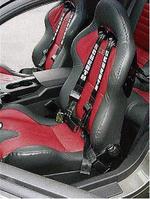Paul Messam, Gleaner writer 
Seat belts are important safety devices. - Contributed
David Jones, a St Andrew-based auto mechanic with over 30 years' experience, made it clear to Automotives that any device that is designed to hold a driver or passenger in the seat during a crash is of paramount importance. These are known as restraint devices.
"When the devices are used, the passengers automatically become part and parcel of the car," said Jones. He explained that using these devices reduces the chance of death or serious injury, because the second crash takes place against a restraint device.
There are three main types of restraint devices: active, passive and child seats. The seat belts that the motorist has to buckle are called active restraints. "They provide very good protection in a crash," Jones points out. These belts must be adjusted properly to give maximum protection. The lower belt should fit snugly across the hips. In an emergency, seat belts can help by holding the passenger behind the steering wheel so he can steer to avoid big problems.
The passive restraints include such mechanisms as airbags and automatic seat belts, which do the same work as active restraints without the need for car occupants to take any action. The airbags inflate instantly when a car hits an object and then deflates after the collision. The automatic seat belt fastens in place as each front-seat occupant enters the car and closes the door. Paul Clemetson, senior director in the Road Safety Unit of the Ministry of Transport and Works, maintains that the death rate in many collisions could be cut dramatically if these devices were used, as required by law.
The child seats are of vital importance, too. When infants or small children ride in cars, they usually have little or no protection. "A driver should always make sure small passengers ride in properly installed and approved child seats," advised Clemetson. If there is no child seat, the child should be buckled into a back-seat seat belt.
Protective devices worthy of note
These are usually built in devices made to improve the passenger protection.
1. Head restraints: Head restraints are padded areas on the front seats to protect occupants when the car is hit from the rear.
2. Front and rear crush areas: Modern motor vehicles have crush areas that increase passenger protection in head-on and rear-end collisions.
3. Padded dash and interior: These exposed areas are padded and knobs are recessed.
4. Energy-absorbing steering wheel and column: Both are designed by the manufacturers to give under impact.
5. Energy-absorbing windshield: In this case, a plastic sheet between the two sheets of glass in a windshield helps to prevent heads from going through the windshield.
6. Side doors beams: The beams inside the car doors reduce the ability of another car to penetrate the passenger compartment.

